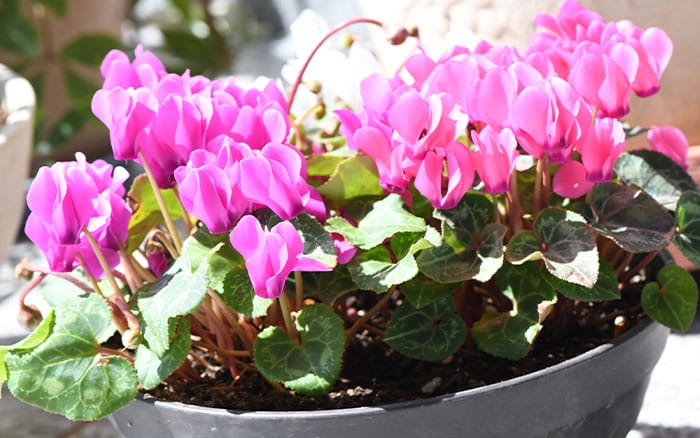Indoor cyclamen is a popular house plants during the winter months. In the right conditions, they can flower for a minimum of six weeks from October! Find out all you need to know to successfully care for indoor cyclamen in your home.
What is the difference between indoor and outdoor cyclamen?
Indoor and outdoor cyclamen are technically two different varieties. Indoor cyclamen, or Cyclamen persicum (Persian cyclamen) is not winter hardy in the UK. This can be found in garden centres in the indoor heated potted plant section. Therefore, it is more likely to thrive when grown indoors during the winter. It is during this period that cyclamen persicum flowers, so can add lovely flowering colour to your home. If in doubt about whether you’re looking at an outdoor or indoor cyclamen, garden centre staff will be able to help you.
So, what is the difference between indoor and outdoor cyclamen? Outdoor cyclamen, cyclamen purpurascens or cyclamen hederifolium (ivy-leaved cyclamen), is much hardier than its indoor counterpart. Therefore, it can cope with UK winters. Indoor cyclamen cannot, so should be grown indoors as a house plant. It’s also otherwise known as ‘Florists cyclamen’, given that it is grown for indoor use, and found in the unheated outdoor plant sales area of the garden centre. Indoor cyclamen can cope in the garden during the warmer months of the year, for more sunlight. However, once autumn and winter set in, bring it indoors to thrive.


How to plant cyclamen indoors
Once you’ve brought your indoor cyclamen home, transfer it into a pot with drainage holes slightly larger than its original container. Provide some additional indoor potting mix to give your indoor cyclamen plenty of nutrition. You can then cover this container with a decorative one of your choice. Perhaps choose a colour which helps your cyclamen’s blooms to pop.

As your indoor cyclamen grows each year, it may eventually need a larger container.
When your cyclamen starts to outgrow its container, repot it into a slightly larger one.
Wait until the autumn when new growth appears, providing some fresh houseplant potting mix.
Ensure the container has plenty of drainage holes, and choose another pot cover or larger decorative container.
Whilst cyclamens are not winter hardy, they won’t cope well in too warm an area of your home.
Try to choose a cool room, which doesn’t get much warmer than 15 C.
Conservatories, and north, or east-facing windowsills are perfect.
Be mindful not to give them too much direct sunlight.

Caring for cyclamen plants indoors
How to water cyclamen
Now, consider your indoor cyclamen plant care. The first step is watering. So how do you water a cyclamen? Firstly, cyclamen like consistently moist but not sodden soil, as they don’t like to sit in water. Overwatering could lead to your cyclamen’s roots rotting, so check the soil beforehand. If the first couple of centimetres of soil are dry, it is the perfect time to water.
Once the spring months descend, your indoor cyclamen will start to enter dormancy. This means it will start to look worse for wear, but this is normal. Reduce watering, and then only water every couple of weeks until autumn returns.

How to feed cyclamen
Next is feeding. Don’t feed your cyclamen too often, or it will produce lots of lovely foliage, but fewer flowers. Add some liquid house plant food every couple of months between September and April. If you can, aim for a low-nitrogen liquid house plant fertiliser. Dilute it to half strength too. During the summer months, whilst the plant is dormant, you can stop feeding completely.
Do you deadhead cyclamen?
Yes, you should deadhead your indoor cyclamen. Carefully pinching off any spent flowers will save your plant energy to produce more lovely blooms. This should helpfully extend your cyclamen’s flowering period for longer.
Indoor cyclamen problem solving
In the warm conditions of your home, you may notice yellowing leaves, poor flowering, or that your indoor cyclamen collapses. This is likely down to overwatering or being in too warm of a room. Cyclamens will struggle in temperatures higher than 15 C, so try to reposition it somewhere cooler. These warmer temperatures will send the cyclamen into early dormancy, which will reduce the flowering period too. Make sure you check the soil before watering, and that the space isn’t too humid.
Indoor cyclamen is also liable to grey mould (Botrytis cinerea). You will notice this as a fuzzy, grey mould appearing on the stems and/or flowers of the plant. This is likely caused by overly humid conditions. Treat this by removing affected plant material. Move into a less humid environment if possible, and when watering avoid splashing the leaves by watering directly into the soil.


With the right indoor cyclamen plant care, these lovely winter-flowerers will continue to look fantastic until spring.

Leave A Comment